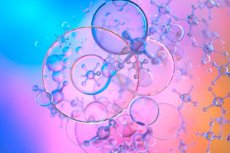New publications
Smart RNA Delivery: How Nanocouriers React to Tumors and Release Genetic Drugs
Last reviewed: 09.08.2025

All iLive content is medically reviewed or fact checked to ensure as much factual accuracy as possible.
We have strict sourcing guidelines and only link to reputable media sites, academic research institutions and, whenever possible, medically peer reviewed studies. Note that the numbers in parentheses ([1], [2], etc.) are clickable links to these studies.
If you feel that any of our content is inaccurate, out-of-date, or otherwise questionable, please select it and press Ctrl + Enter.

Scientists from Hebei Medical University, Peking University and their colleagues published a review article in Theranostics, which summarized the latest achievements in the field of stimulus-responsive nanocouriers for the delivery of therapeutic RNA molecules to tumor tissue. Such nanostructures remain in a stable “dormant” state in the bloodstream, but are activated precisely at the “hot spots” of the tumor due to internal (endogenous) or external (exogenous) stimuli, ensuring maximum efficiency and reducing side effects.
Endogenous tumor markers are “locks” for RNA
Acidity (pH 6.5–6.8).
Imine, hydrazone or acetal bridges are used, which are destroyed at the reduced pH of the tumor micromilue.
Example: lipid-peptide nanocapsules with siRNA against VEGF, released in an acidic environment and suppressing angiogenesis.
Oxidation-reduction potential (↑GSH, ↑ROS).
Disulfide bonds within the polymer matrix are cleaved by excess glutathione in the cytosol of the cancer cell.
Thioketone "locks" are reversible at high ROS levels.
In practice, a polymeric siRNA-PLK1 carrier activated in high-GSH melanoma showed 75% growth inhibition.
Tumor stromal proteases (MMPs).
The outer shell of the nanoparticles is made from MMP-2/9 peptide substrates.
Upon contact with tumor protease secretion, the shell is “torn off”, the RNA cargo is exposed and absorbed by the cell.
Exogenous "triggers" - control from outside
Photosensitivity.
Nanoparticles coated with photolabile groups (o-nitrobenzylidene) are “unpacked” under 405 nm LED light.
Demonstration: PD-L1 mRNA vaccine was released into tumors under ambient light, enhancing T cell responses.
Ultrasound and magnetic field.
Acoustic-sensitive siRNA-containing vesicles are ruptured by low-intensity ultrasound, which increases the penetration of calcium ions, activating apoptosis.
Superparamagnetic nanoparticles with magnetically sensitive layers are injected into the tumor area, and an external magnetic field heats them and releases the mRNA scaffold.
Multi-mode "smart" platforms
- pH + light: double-coated nanoparticles - first the "alkaline" shield is shed in the acidic tumor environment, then the inner photodegradable layer releases the cargo.
- GSH + heat: heat-activated liposomes whose disulfide “locks” are additionally sensitive to local hyperthermia (42°C) generated by an infrared laser.
Advantages and challenges
- High specificity. Minimal loss of RNA in the systemic circulation, delivery selectivity > 90%.
- Low toxicity. No liver or nephrotoxicity in preclinical models.
- Potential for personalization. Selection of “triggers” for the profile of a specific tumor (pH, GSH, MMP).
But:
- Scaling. Difficulties of multicomponent synthesis and quality control on industrial scale.
- Standardization of "triggers". Precise criteria for pH, GSH levels and ultrasound/light doses in patients are needed.
- Regulatory Pathway: Challenges of FDA/EMA Approval of Multifunctional Nanotherapeutics Without Clear Pharmacokinetic Data
Perspectives and comments from the authors
“These platforms represent the future standard of RNA therapies: they combine stability, precision and controllability,” says Dr. Li Hui (Hebei Medical University). “The next step is to create hybrid ‘hardware-software’ solutions, where external stimuli are delivered through portable devices directly to the clinic.”
“The key to success is the flexibility of the system: we can easily change the composition of the ‘locks’ and ‘keys’ for different tumor markers and clinical scenarios,” adds co-author Prof. Chen Ying (Peking University).
The authors emphasize four key points:
High controllability:
“We have shown that the choice of ‘triggers’ allows us to precisely target RNA delivery – from pH to light and ultrasound – and thus minimise side effects,” notes Dr Li Hui.Platform flexibility:
“Our system is modular: simply replace the pH-sensitive ‘lock’ or add a photolabile component to adapt to any tumor type or therapeutic RNA,” adds Prof. Chen Ying.Path to the clinic:
“While the preclinical data are promising, we still need to work on standardizing the synthesis and conducting comprehensive safety testing to overcome regulatory hurdles,” emphasizes co-author Dr. Wang Feng.Personalized therapy:
“In the future, smart nanocouriers will be able to integrate with diagnostic sensors, automatically selecting the optimal activation conditions for each patient,” concludes Dr. Zhang Mei.
These stimulus-responsive nanocouriers promise to transform RNA therapies from a laboratory sensation into everyday oncology practice, where every patient will receive a precise, programmable and safe treatment at the molecular level.
